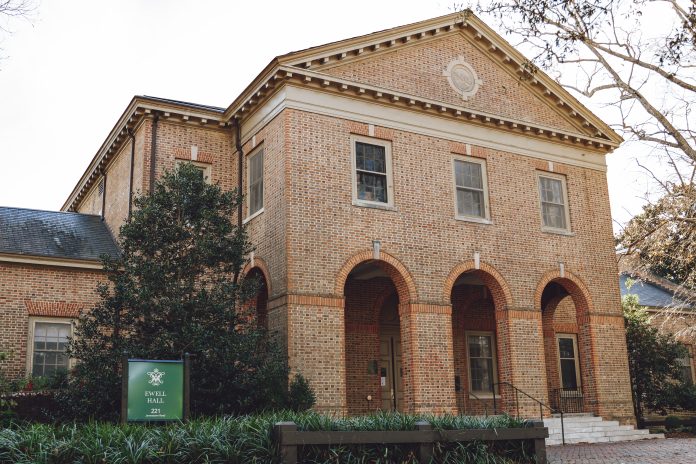Friday, Nov. 12, the College of William and Mary Middle Eastern Music Ensemble had their first in-person performance since before the pandemic in the Ewell Recital Hall, hosting Johnny Faraj as a guest performer.
The ensemble formed in 1994, making it the third Middle Eastern music ensemble ever on a college campus in America. The group began to manifest around the catalyst of the ensemble, the director of the group professor Anne Rasmussen. Studying ethnomusicology at UCLA, professor Rasmussen had learned to play the oud and experience Arab music groups, a fact of interest for students wanting to learn or continue to play Arabic music.
“Students at William and Mary found out I could play, and they wanted to start a little group, so we started a little group,” Rasmussen said. “And it became a bigger group, and that’s what happened.”
Since its humble beginnings, the Middle Eastern Music Ensemble has had numerous guest performers and has even been able to travel to the sources of its music a few times. Professor Jonathan Glasser, a member of the ensemble since 2006, said those are some of his favorite memories from his time with the group.
“Probably one of my favorite experiences was bringing two close friends from Morocco,” Glasser said. “People I first got to know doing my dissertation fieldwork, and having them come here twice, once in 2012 and 2016 …We’ve also gone with the ensemble to Oman, and to Morocco to kind of return that visit, in fact.”
When asked about the evolution of the group since its beginning, Rasmussen said it’s constantly changing — always gaining and losing members with the coming and going of students to and from the College.
“The ensemble is always evolving … the minute it gets good, all the good people graduate, Rasmussen said. “You know, you’re always losing your best musicians … but this year’s group, they’re all at rehearsals, they’re all into it, they’re good musicians, they’re wonderful people, so I’m pretty excited about our concert.”
Haytham Alsayed ’25 has been able to use his training in opera while also learning new instruments he’s always had an interest in through the ensemble.
“When I came across the Middle Eastern Music Ensemble, it immediately caught my attention,” Alsayed said. “Joining would give me the opportunity to play the oud and sing in Arabic. I knew it would be a great fit for me because it had the potential to combine my passion for singing with my childhood dream of learning to play an Arabic instrument.”
The concert itself was an amazing demonstration of the ensemble’s skill, with every part of the ensemble working together without the help of a conductor. Rather, throughout the performance, Rasmussen played the qanun, occasionally giving signals to soloists whose parts were coming up, and conducted very little. The rest of the group played together in sync, listening to each other to stay perfectly in time. There was an overwhelming sense of freedom in the music. Unrestricted by either conductor or strict sheet music, everyone just played — and played incredibly well.
“I think for a lot of people who have a background in Western classical music, or band music and things like that, it’s a big breath of fresh air, because it is much less authoritarian,” Glasser said. “There’s a lot more improvisation; there’s not somebody conducting, and we do use some written music, though that’s really a very loose guide to what you actually want to play. So it really has a very distinct vibe, and it’s a huge amount of fun.”
Echoing this sentiment, Alsayed commented on how the pieces they perform are a collaborative effort from the entire group.
“Since traditional Arabic music doesn’t really have much concept of harmony, our sheet music just contains a notated melody and instructions for which rhythmic pattern should be played by the percussion section.” Alsayed said. “There isn’t typically any designation of different parts to different instruments, so we work together to decide which instruments will dominate which phrases and sections. We basically craft the sound of the piece from the ground up using the melodic line and rhythmic pattern as a blueprint.”
Beginning with the second song, the whole ensemble too began to sing in Arabic. Alsayed also had a few vocal solos, hypnotizing the audience with his beautiful singing, and supported by the collective vocals of the ensemble.
About halfway through the concert, the guest performer, Johnny Faraj, was introduced. He sat at the far end of the front row percussion section playing a riqq. Both Rasmussen and Alsayed gushed about him and the impact of his presence on the ensemble.
“My favorite experience thus far was the concert with our guest artist, Johnny Farraj,” Alsayed said. “It was wonderful getting to work with and learn from him, and his passion for his art truly inspired all of us.”
“To bring somebody like Johnny to hangout with us, to sit with us, to collaborate with us, not just as a speaker that, you know, we’re going to read their article and then they’re going to give us some talk, right, but someone that’s going to sit down and play music with us, and then offer that music to the ensemble, is really important.” Rasmussen said. “The ensemble is a really great platform to be able to bring people together.”
After the last song, there was an encore performance in which the director encouraged the audience to clap, sing and dance along. Many of the audience members joined, adding to the collaborative spirit of the ensemble. Afterward, the director thanked everyone for coming, and the audience gave a standing ovation.

